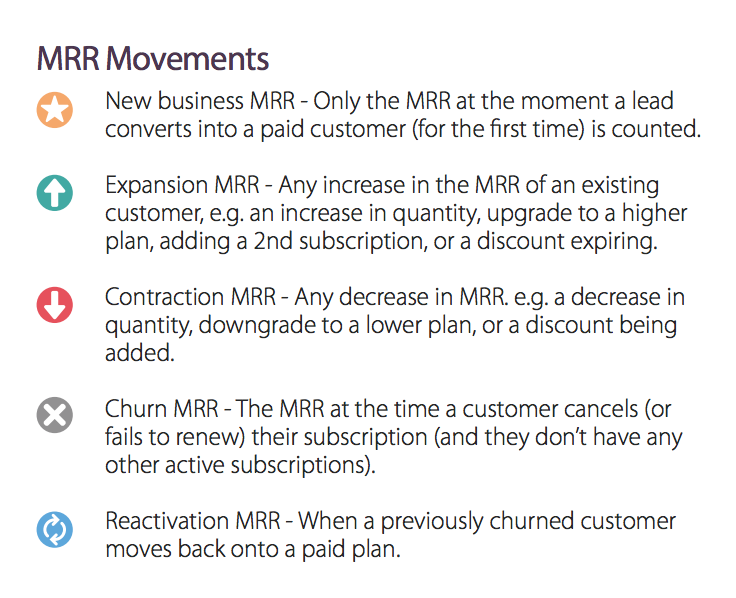“If you want to move numbers in the right direction, you need to get people to care about them.”
– Hubspot
Most employees of a subscription business know that Monthly Recurring Revenue (MRR) is the engine of the company and the primary indicator of its growth.
But when it comes to business goals and their corresponding metrics, they can be a bit abstract or removed from the daily function of many team members. Most employees stay focused on those to do with their specific team. The dreaded “silo” effect sets in, and this is increasingly the case as a business gets larger, headcount grows, and teams specialize.
- Marketing focuses on conversion rates
- Engineering on speed and reliability
- Customer success on retention
… And so on. These are the quantitative targets they know they need to hit. These are the targets that directly reflect their effort and performance, that determine their chances for a promotion, and that serve as stepping stones for their career.
But when employees can directly tie their own team’s performance and numbers to the larger business metrics of the company, it creates what the startup world loves to call “buy in.” It’s a date-driven way of connecting individual effort to the overall vision of the company, to the company’s progress in pursuit of its mission.
And when employees recognize their role in these company-wide metrics, when they feel their impact on the company’s trajectory, that fosters a strong culture of ownership, teamwork, and ultimately — innovation.
“The best run companies are data-driven, and this skill sets businesses apart from their competition.”
MRR, the metric
To begin, the metric must be “well-defined, communicated clearly to the workforce and consistently measured.” (Forbes) And from there, you can educate teams on how their individual effort ties in to help move the needle.

[Source: The Ultimate SaaS Metrics Cheat Sheet]
It contains five movements:

In other words…
New business MRR: The revenue value of brand new customers.
Expansion MRR: Satisfied customers who increase the number of seats/licenses, upgrade to a higher plan, or add a second subscription.
Contraction MRR: Customers scale back their subscription by decreasing number of seats/licenses or downgrading to a lower plan.
Churn MRR: The revenue value of completely cancelled accounts.
Reactivation MRR: Formerly cancelled customers who come back on board.
Breaking down MRR per team
When it comes to this revenue metric, the connection to the Sales team is obvious. MRR is a key metric for Sales already. So let’s take a look at the more tangential relationships that exist between other teams and MRR.
Marketing
If marketing’s primary objective is to bring new revenue INTO the business, how do you get them to care about what happens after the sale? What can they learn about the effectiveness of their channels and campaigns?
New business MRR: New business can be tied back to acquisition efforts in various marketing channels. It reflects their success in expanding the brand’s audience, gaining exposure and trust, and converting leads to new customers for the first time.
Expansion MRR: Expansion can be tied to ongoing marketing initiatives that promote customer success, such as content marketing through a blog or newsletter.
Churn MRR: Churn, when segmented and analyzed by marketing channel, can identify which marketing channels are bringing in consistently unsuccessful customers. And from there, marketing change strategy so they are not wasting effort acquiring customers that, in turn, waste the effort of other teams.
Reactivation MRR: Reactivation is a great metric to tie back to the marketing team if they have a hand in nurturing cancelled accounts, keeping them warm, and bringing them back around. This can be done through email marketing, sending both content newsletters and also relevant product announcements.
Customer Success
Expansion MRR: The connection here is pretty straightforward. A main objective of the Customer Success team is to expand the existing portfolio of business through upgrades and add-ons. As such Expansion MRR is most directly tied to this team. And as the SaaS company grows and expansion MRR becomes the engine of the business, it’s important for the team to keep a clear eye on this segment of the metric.
Contraction MRR: The other main objective of Customer Success is to keep revenue from leaking out of the business. Contraction MRR is a good indication of the customer success team’s ability to prevent shrinking account sizes and service downgrades.
Churn MRR: The connection between Customer Success and Churn MRR is also clear. In the same vein as Contraction MRR, Churn is Customer Success’s enemy #1. Churn overtime reflects on the team’s ability to keep customers satisfied and on board, but any temporary spikes or waves in cancellations could likely reflect back on marketing or sales — whether the lead was qualified and whether expectations were properly set before the deal was closed.
Product & Engineering
When it comes to Monthly Recurring Revenue, you can measure Product directly on two fronts: New Business and Retention. The engineering team’s effort plays into these as well.
New business MRR: New business can be tied back to new product features that are meant to target new markets. If you’re e-commerce, new business can be generated by new site capabilities or new UX flows that simplify and smoothen the shopping/buying process.
Churn MRR: Churn could be tied to performance issues within the product, and thus the Product team’s ability to launch features that run smoothly and release timely, thorough fixes.
“It’s always important to know reasons for Churn. Bugs are the ones that impact Product most.” – Vinay Seshadri, Director of Product at ChartMogul
The flipside of Churn, retention, also comes into play here. Retained MRR, or just retention rate, could be attributed to product features meant to increase user engagement and deliver more value to the customers.
“Being able tag your MRR reports with Product events (like a new release) helps accurately attribute MRR to product changes.” – Vinay
On that note…
If you’re using an analytics tool, or are in the market for one, check to see that it has the ability to segment your data, particularly the ability to add custom tags. This feature is helpful beyond just product events. For example, you can tag accounts with the name of the sales rep who closed the deal. Then later, segment your MRR data by sales rep to easily monitor individual performance.
Another helpful feature in an analytics tool is cohort analysis, which reveals trends in your customer base over their life cycle. That spike in cancellations I mentioned? Cohort analysis can determine whether those customers came on board in one particular month, making it easier to review best practices and move forward.
Other ways to foster data throughout the team
Give team members access to the data.
Personal dashboards, a mounted screen in the office, or even handwriting on a white board — display the latest MRR numbers. At ChartMogul we use our own “MRR in the last 30 days” chart. It updates in real time and is available to the whole company through our app’s dashboard.

Send routine updates.
Particularly if you have remote teams, it’s helpful to have these numbers recorded. The frequency is up to you — weekly, biweekly or monthly. Oral KPI updates, like in meetings, can often go in one ear and out the other. With this email, the numbers are physically in front of everyone, and people can refer back to it if need be.
Reflect on the numbers as a team.
When MRR goals are reached, celebrate! When goals are missed, discuss reasons why. Not only does this cultivate further understanding of the metric and one’s role in it, but reflection also informs the game plan for moving forward. Decisions become transparent — and everyone not only understands the decisions, but feels a part of the decision-making process. Then when next steps are clear, everyone is aligned to move forward.
